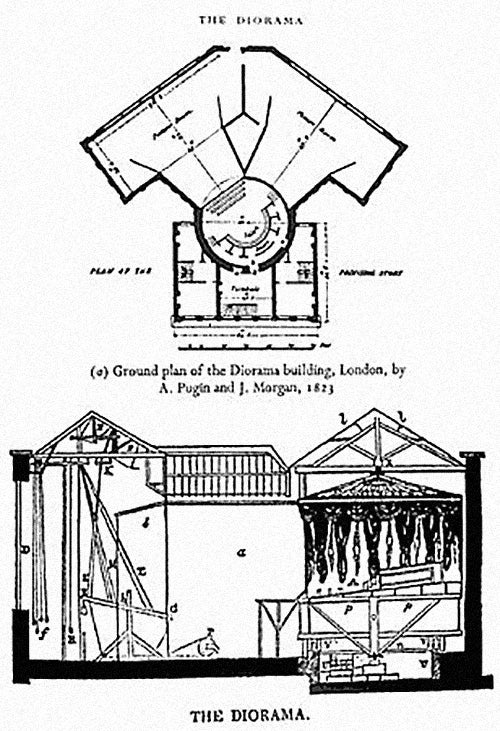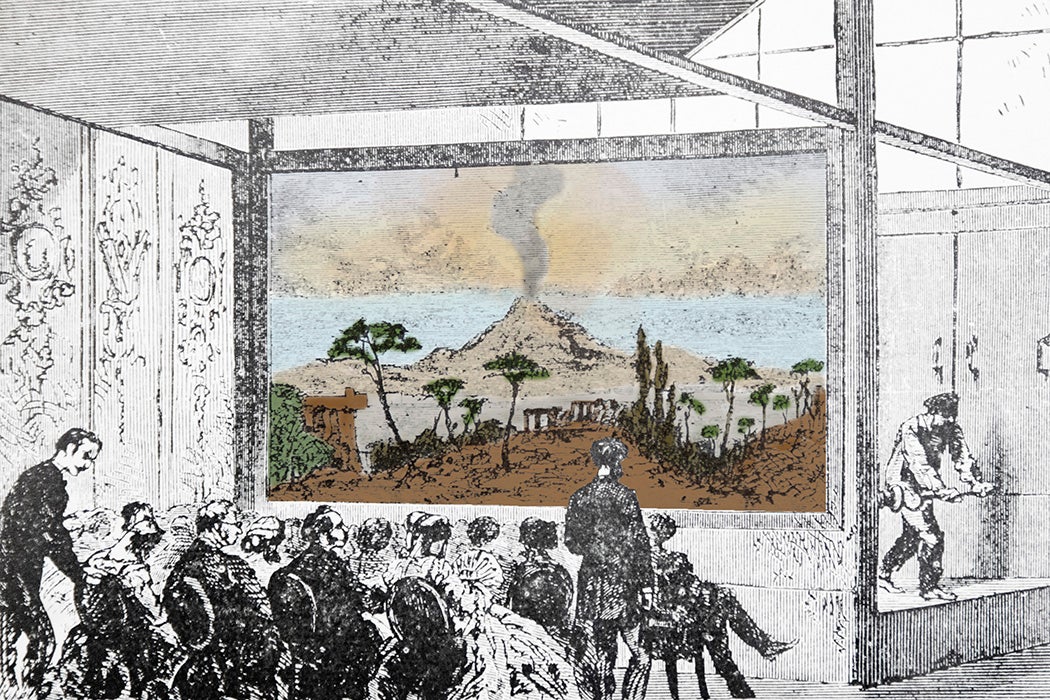London. February 20, 1826. It’s pitch black in a small, slightly cramped theater—the kind of inky black darkness that makes the viewers forget where or when they are. Suddenly, the sun begins to rise, only within the building. Not the real sun, which rose several hours ago, but a near-perfect, sped-up replica. Once the viewers’ eyes adjust they see that they are no longer in a small theater, but in Rosslyn Chapel, a stunning feat of fifteenth-century architecture located not in London, but in rural Scotland. Light shines through the ruin’s wonders, fading briefly as clouds pass over the sun. The sound of bagpipes plays in the distance.
The viewers were inside the work of a French inventor, Louis Daguerre. The diorama was one of his many inventions, a multimedia spectacle that took the mid-nineteenth century by storm. The first diorama was constructed in 1822, behind the Place du Château d’Eau (now the Place de la République). Daguerre’s studio was located in the 10th arrondissement, in Paris, rue Faubourg du Temple; the area was shabby and underdeveloped, consisting of old army barracks and a smattering of theaters. Once customers entered the theater, however, they soon forgot their dilapidated surroundings. They were transported, as it were virtually, to places and moments in history: the Black Forest; the Inauguration of the Temple of Solomon; the Great Fire of Edinburgh.
Weekly Newsletter
The diorama quickly grew extremely popular, garnering as much as 200,000 francs a year during its heyday, a remarkable profit for the era. Diorama theaters were built in London and Berlin, with the most famous tableaux touring between cities.
Before creating the diorama, Daguerre apprenticed with the panorama painter Pierre Prévost. Panoramas were a popular form of entertainment in the early-to-mid nineteenth century. The customer would stand on a raised platform surrounded by a highly realistic panoramic painting. As though on a mountain peak or atop a high building, the viewer would look out upon exotic locales, far-flung cityscapes, and historical battle scenes. Daguerre’s diorama went several steps further by animating the scenes.
The diorama projection show has long been touted as the direct precursor to cinema, but one might also link it to virtual reality. Unlike the panorama and other spectacles like the cycloramas that came before it, the Diorama was an entirely immersive experience, transporting participants using advanced painting techniques, light tricks, and sound. As the science and technology historian John Tresch details in the journal Grey Room:
More than just a new kind of painting, the diorama was an immersive, hallucinatory experience housed in a specially made building that allowed an audience to gather in a darkened room watching a lighted screen, transparent and opaque at various points, slowly transform itself from night to day, from winter to summer, often accompanied by music and other sound effects.
While a panorama could be placed in any large room, a special building had to be constructed for a diorama. The viewing platform rotated to show viewers two and sometimes three different views of the scene. Simultaneously, technicians behind the screen would use tricks of the light to create the illusion of the passage of time. “The diorama was the most elaborate and most commercially successful variant of the technology of the ‘magic lantern,’” explains the musicologist Thomas S. Grey in an article in 19th-Century Music. Grey continues:
Rather than working with slides, however, the diorama manipulated natural daylight by a complex of screens, shutters, curtains, colored filters, and so forth to illuminate images painted directly on large, scrim-like hangings (averaging about seventy by forty-five feet in area).
For example, one of Daguerre’s dioramas portrayed a midnight mass. Viewers first saw an empty chapel filled with sunlight. But gradually the light darkened as the sun set. Candles illuminated as the pews filled with people.
Daguerre’s diorama techniques quickly revolutionized stage production. Directors, playwrights, and composers began integrating the technology into their shows. Rather than having stagnant painted backgrounds, they used Daguerre’s mixture of translucent and opaque paints to create living scenes that would evolve along with the production. Perhaps the best example was Giacomo Meyerbeer’s ballet Robert le Diable. Opening on November 21, 1831, Meyerbeer’s opus quickly became the most popular ballet of the era, not only for its engaging plot, but for its use of advanced special effects. “The ruins of the third act,” wrote the French newspaper Le Figaro, “are as perfect in effect and scheme as one of the ingenious Dioramas of M. Daguerre.”

Scientists also showed great interest in the diorama projection show. The Prussian explorer Alexander von Humboldt suggested in his book Cosmos that diorama and panorama techniques could be used to create a form of virtual travel. Von Humboldt seggested that “large panoramic buildings containing a succession of such landscapes” should be built in cities and opened to the public as “a powerful means of rendering the sublime grandeur of the creation more widely known and felt.”
Today, be it through a nature documentary, Google Earth, VR, or some other means, the ability to immersively experience far-off locales is highly accessible. During the era of Daguerre’s diorama, this was not the case. While the curious could see prints and drawings made by explorers, or perhaps visit a museum to view specimens of flora and fauna collected from exotic places, without photography or cinema, they could never experience these places. As the musical theater scholar Anno Mungen theorizes in his article “Entering the Musical Picture:”
…the most important point of the Diorama idea was to replace the actual reality with a different one and to expose the audience to a complete artificial world as represented by the painting as well as by the whole setting and situation of the performance…
The experience of the diorama was unlike any other spectacle of the time. Much like a movie theater, the specially-made theater was kept pitch black, save for the illuminated screen. When viewers entered this neutral space, they could forget their reality and be transported to the worlds that danced before them. The French essayist Jules Janin described the experience in 1839, stating: “Daguerre has brought us inside of the tableau, whereas, before him, we only saw the surface.”
The diorama is, therefore, one of the first examples of time-and-space-binding media. Later in the nineteenth century, technologies like the telegraph and telephone irrevocably changed human perceptions of space, near-instantaneously connecting people from hundreds of miles away. At the same time, photography and cinema froze moments in time to be viewed by people in the future. While we take these experiences for granted today, imagine how incredible it would have been for viewers of the diorama who, in 1822, had never experienced any form of virtual media.
On March 8, 1839, a fire broke out in the Parisian diorama. Although this upset Daguerre, the diorama was already reaching its natural end. He was far more focused on the development of the daguerreotype. He urged firefighters to, at all costs, prevent the blaze from spreading to the fifth floor of the adjacent building, which held all of his daguerreotype specimens, notes, and equipment.
Daguerre had previously taken great interest in his compatriot Nicéphore Niépce’s experiments in “heliography,” which temporarily captured camera obscura images on bitumen-coated pewter plates. In 1837, Daguerre discovered how to make the images on the plates permanent by soaking them in hot saturated saltwater, inventing the world’s first true photographs. Had his workshop been destroyed in lieu of the diorama, the history of media would look very different today. Photography, cinema, and television might all have been delayed—or manifested themselves differently, perhaps in unrecognizable ways. It is strangely poetic that the diorama, the direct precursor to both photography and cinema, had to die in order to save the future of technology.
Just a few months later, in August 1839, the daguerreotype debuted. In the decades that followed, with the rise of motion photography and cinema, people soon forgot all about the wonders of the diorama. However, the human desire for virtual experience has remained constant. Is our fascination with VR headsets really all that different from the diorama-mania of the mid-nineteenth century? Presented to the public nearly 200 years ago, the diorama can be seen as part of the human dream of virtual experience, a dream that links us to our past and to the people, like Louis Daguerre, who inhabited it.







